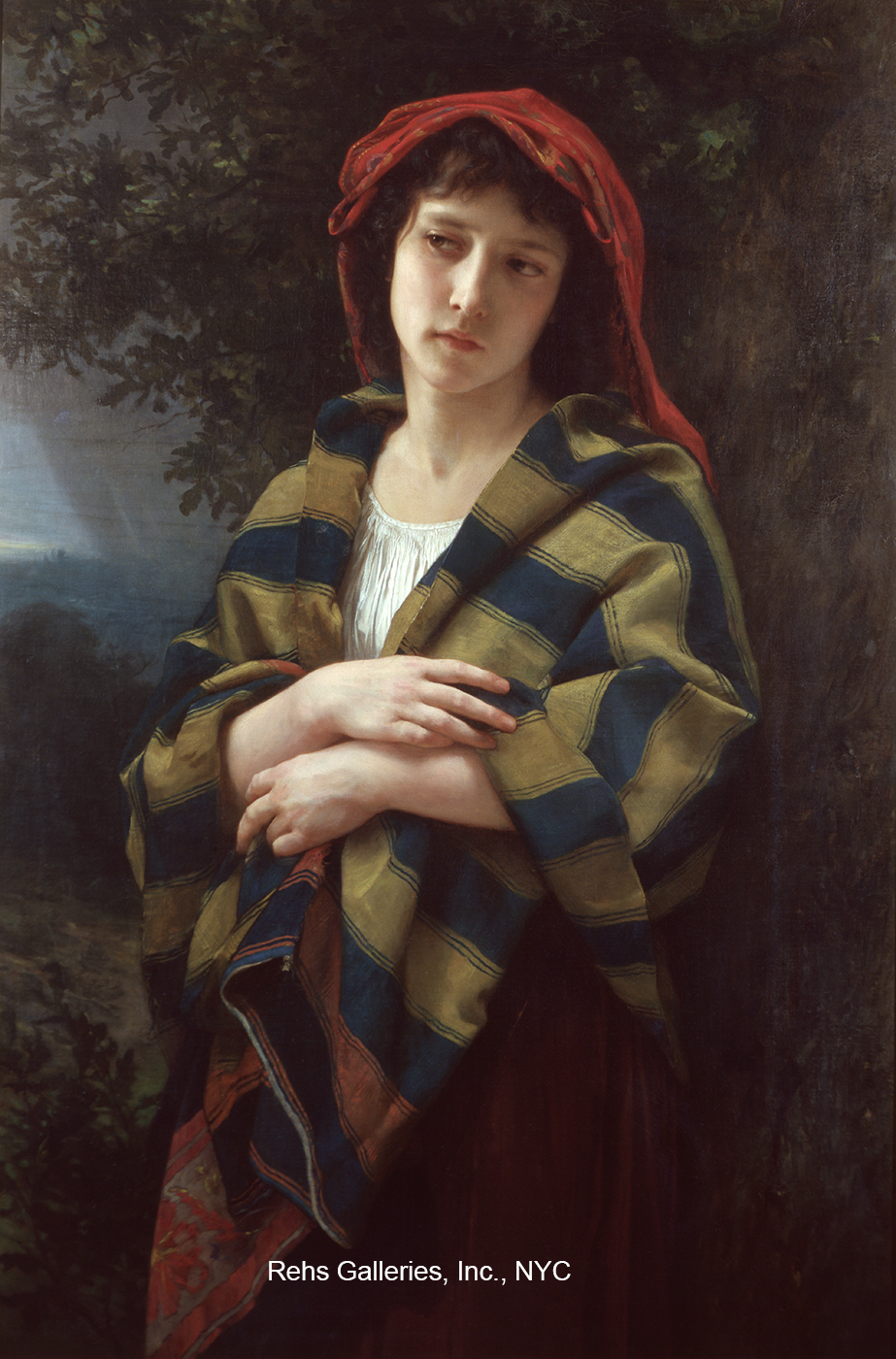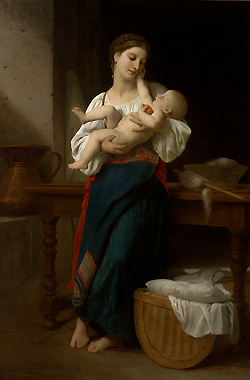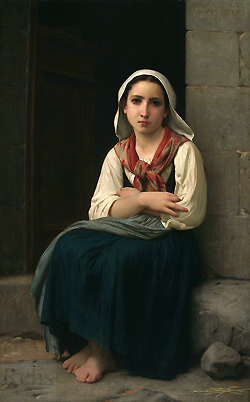William A. Bouguereau - The Academic Tradition Personified
When will the day come when I can do something worthy of a grown man? How many things must I yet learn before reaching that stage!
- Bouguereau, May 13, 1848
Early in his career, William Bouguereau was a young artist dealing with the uncertainty of the quality of his work within the critical Parisian art scene, anxious over the issues of training and his professional ability. Bouguereau had little idea of the immense success that he would achieve and how rapidly it would find him. Later he would have a moment of reflection where he almost began to grasp his future potential:
Today, I am more confident, my heart is open to hope, I have faith in myself. No, the laborious studies I work at are not useless, the road I am following is a good one, and with the help of God, I shall achieve glory, a just and a pure glory.
These initial misgivings about his talent and future were exactly what drove Bouguereau to greater perfection in his work and which established him as one of the leading artists of the academic tradition in the nineteenth century.
Adolphe-William Bouguereau worked during a key moment in the creation of an artistic revolution. The École des Beaux-Arts, with its perceived pedantry and oppressive historicism, began to fall out of favor with many younger artists in the 1860’s. A new group of artists challenged the pre-established artistic conventions, seeking a comprehensible and contemporary style which relied on features of the landscape, society, and which was free of overbearing historicism. While many artists proclaimed the ideas of a new socialism by challenging the École system, Bouguereau remained an ardent supporter of a way of painting that was, especially towards the end of his career, the symbol of the opposition to modernism. He sought the beautiful in life and art, not necessarily the socially and politically challenging. He said:
In painting, I am an idealist. I see only the beautiful in art and, for me, art is the beautiful. Why reproduce what is ugly in nature? I do not see why it should be necessary. Painting what one sees just as it is, no-or at least, not unless one is immensely gifted. Talent is all-redeeming and can excuse anything. Nowadays, painters go much too far, just as writers and realist novelists do. There is no way of telling where they’ll draw the line.
While his work may have fallen out of favor with many of the younger artists during the late nineteenth century, Bouguereau’s work and style of painting were nonetheless widely appreciated in France and also found great popularity in America during the nineteenth century. More recently, a re-evaluation of Bouguereau’s approach has led to a revived appreciation from a new audience.
Bouguereau was born in La Rochelle on November 30, 1825, the second of four children. His father, Élie-Sulpice-Théodore Bouguereau was a wine merchant whose family descended from an old Huguenot family. His mother was Marie-Marguerite-Adeline Bonnin, of whom little is known. Several years after relocating to Saint-Martin de Re, Bouguereau boarded with his uncle Eugène Bouguereau in Pons who taught him Latin and instilled in him a great admiration for biblical writings and classical texts.
Bouguereau began his artistic training in 1838, attending drawing lessons with Louis Sage, a former pupil of Jean-Dominique Ingres, a well-known neo-classical painter. His training was interrupted in 1841 after his father moved the family to Bordeaux and established a new business in the trade of olive oil. His father sent for his assistance, always hoping that his son would take over the family business, but both he and his father, much to his father’s disappointment, realized that Bouguereau was more interested in filling the ledgers with drawings than with paid receipts. After working another job with a wine merchant, Bouguereau earned enough money to enter the École Municipale de Dessin et de Peinture in Bordeaux, where Jean-Paul Alaux, after some persuasion, moved Bouguereau to the advanced class. So began the true artistic training of Bouguereau. He boarded again with his uncle, Eugène, who introduced him to many of his friends for whom he painted portraits during the next few months. After gaining enough money from commissions, he moved to Paris in March of 1846. He enrolled in courses under the celebrated Francois-Edouard Picot, who he then persuaded to recommend him for entry into the École des Beaux-Arts. Bouguereau just made the cut, placing ninety-ninth out of a hundred for entry into the École. Although relocating to Paris, he maintained strong ties with his birth city, La Rochelle, returning often when the École had vacation periods. This would be to his benefit as in 1848 the city of La Rochelle determined the importance of assisting Bouguereau in his continuation of artistic studies and provided him 500 francs, simply to encourage his continuation of artistic studies.
Throughout both his studies and his professional artistic career, Bouguereau had a work ethic that was equal to none. A full-size figure could be completed over a period of roughly eight days, but it was his extensive preparatory work, as suggested by an anonymous quote, that was also significant:
This impeccable painting, in which everything is depicted with the utmost care, where the slightest detail is lovingly rendered, was not easily achieved. The material execution was confident and rapid, but the preparations were lengthy and carefully thought out, each subject being weighed and looked at every which way with the help of studies, full size cartoons, and numerous painted sketches
Bouguereau was a constant perfectionist in his own work, often reworking the composition after it was technically complete.
Bouguereau first exhibited at the Salon in 1849 with Égalité devant la Mort (Equality Before Death). He was preparing for his entrance to the art world during the very tumultuous social and economic period between 1848 and 1849 when Louis Philippe and the July Monarchy were overthrown. Despite his non-political nature, Bouguereau was a patriot and expressed this by joining the National Guard on the side of the monarchy. In June 1848 he fought alongside his friend Isidore Pils, another artist who would become a central teacher at the École des Beaux-Arts. The fighting would change Bouguereau and after this period he resolved to “keep carefully away from their world, offering and requesting nothing that could be construed as a statement, public or private, of opinion for or against any system of government.”
The political uprising also affected the yearly Salons and the 1848 Prix de Rome was not given that year. Considering this, a second Prix de Rome was given in 1849 and a young Bouguereau was the recipient, for his Zénobie Retrouvée par les Bergers sur les Bords de l'Araxe (Zenobia Discovered by Shepherds on the Bank of the River Araxes), though it only provid ed him three years in Rome instead of four. He left in December 1850 and arrived at the Villa Medici before the first of January. Paul Baudry, later to live in Bouguereau’s atelier while he was gone, provided a humorous description:
I live in Bouguereau’s studio, at the bottom of the garden; I don’t know whether you’ve ever seen it, its door is so well hidden behind laurels and boxwood. The bedroom is adjacent to it and I am quite alone in my retreat. Rats and the songs of nightbirds sometimes give me nightmares; but I become braver. At least, I am more daring than my predecessor, who couldn’t sleep without having a loaded gun at his bedside.
During the next few years Bouguereau traveled extensively throughout the Italian cities and countryside, making many copies of works by great Italian masters. His stay in Italy lasted three years and four months, and upon his return to France he exhibited Le Triomphe du Martyr (The Triumph of the Martyr) at the Salon of 1854. He also took part in the Exposition Universelle of 1855 where he received a medal.
Bouguereau’s popularity increased, as did the demand for larger commissions. In 1856 the state commissioned him to paint Napoleon III in Napoléon III Visitant les Inondés de Tarascon (Juin 1856) (Napoleon III Visiting the Flood Victims of Tarascon), his only true attempt at contemporary historical painting. He was also commissioned by religious organizations to provide decoration for their churches, such as his work for the chapel of St. Louis at the Sainte-Clothilde church in Paris (1859), and ceiling decorations for the chapels of St. Pierre-Paul and St. Jean-Baptiste at the St. Augustin Church in Paris (1867). In 1869 he painted decorations and the ceiling of the Salle des Concerts at the Grand Théâtre de Bordeaux.
The late 1860’s began yet another period of political and social upheaval in Paris surrounding the Commune. Responding again to his patriotic inclinations, Bouguereau enlisted in the National Guard. A painting from this period, Les Ruines des Tuileries au Louvre (The Ruins of the Tuileries Building at the Louvre), has become one of the most deeply valued images of the destruction of Paris suggesting that Bouguereau was, at heart, a deeply observant painter who worked occasionally within the tenets of the Realist aesthetic. After the fighting was over in 1871, he carried his patriotism into his desire to run for election in the National Assembly in his home city of La Rochelle. He quickly realized that he preferred painting after being mistaken for a German spy and being almost executed in Orléans. He and his family returned to Paris after this slight flight of fancy and in 1875 he began teaching at the Académie Julian in Paris, a respected yet somewhat more liberal institution that allowed women to attend classes. One quote attests to his status as an artistic demi-god, as:
You would never believe the “relics” that the American women sent home to their country, the most highly prized of these being a broken matchstick the great man had used; the ladies would snatch at the cigarette that he politely disposed of…
On January 8th, 1876 he was elected to the Académie des Beaux-Arts de l’Institut de France. Of this honor he wrote, “To become a member of the Institut…is the only public distinction I ever really wanted.” This great joy was overshadowed by the death of one of his sons and his wife, Nelly, who died in 1877. Shortly after her death he began a long courtship with one of the American students he met at the Académie Julian, Elizabeth Jane Gardner. They would not marry until after his mother’s death in 1896. During this period Bouguereau continued as a very active teacher at the Académie Julian where he was especially sought after by young women who valued his teaching experience and his ability to work with them in establishing professional artistic careers.
After his battle with heart disease, William Bouguereau died in his home on the rue Verdière at La Rochelle during the night of August 19th, 1905. His career brought him from a more severe, historically based style influenced by classical texts and his period in Italy, to one that showed a freer expression of emotion focusing on Parisian scenes, children, and the essence of charity. Through his teachings and numerous Salon showings, he established a group of followers and gained recognition from many as a master of his trade. His last Salon entry was the year of his death when he exhibited L’Océanide (Ocean Nymph).
Bouguereau received almost every recompense possible during his career: Chevalier de la Légion d’Honneur (1857); Member of the Académie Royale des Beaux-Arts of Amsterdam (1866); Member of the Institut de France, Académie des Beaux-Arts, Officier de la Légion d’Honneur (1876); President of the Société des Artistes Français (1881); President of the Association des Artistes founded by Baron Taylor (1883); Professor at the École Nationale Supérieure des Beaux-Arts (1888); Member of the Academy Royale des Beaux-Arts of Anvers, Commandeur de l’Ordre d’Isabella Catholique (1889); Associated Member of the Académie Royale des Sciences, des Lettres et des Beaux-Arts of Belgium (1890); Commandeur de l’Ordre de Leopold (1895); Grand Officier de la Légion d’Honneur (1903); President of a number of prize juries for expositions both in France and abroad. He was one of the last members of the academic tradition, an artist whose works are deeply prized today as the academic tradition has regained its importance. There are many who follow Bouguereau’s teachings as fundamental precepts for creativity
The quotes in this biography have come from the primary source of information on William Bouguereau from the 1984 exhibition organized by the Montreal Museum of Fine Arts: William Bouguereau 1825-1905. Montreal Museum of Fine Arts: 1984. For further information on his teaching at the Académie Julian including photos, see Overcoming All Obstacles: The Women of the Académie Julian, Rutgers University Press: 1999.
For publications featuring the works of William A. Bouguereau
please visit our BOOKS page.
 William A. Bouguereau (1825 - 1905) Le depart du bergère 24 1/2 x 19 1/8 inches Signed SOLD Request More Info |
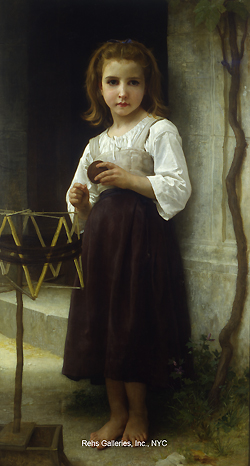 William A. Bouguereau (1825 - 1905) Le Peloton de Laine 55 x 30 inches Signed and dated 1886 SOLD Request More Info |
 William A. Bouguereau (1825 - 1905) Tête d'Etude l'Oiseau 32 x 26 inches Signed & dated 1867 SOLD Request More Info |
|
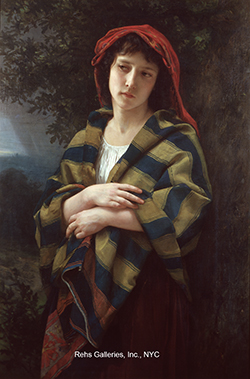 William A. Bouguereau (1825 - 1905) Pendant l'Orage 40 x 27 inches Signed & dated 1872 SOLD Request More Info |
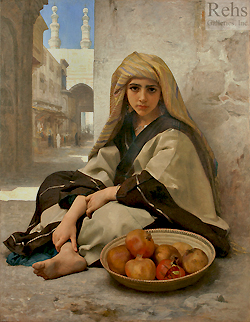 William A. Bouguereau (1825 - 1905) Marchande de grenades (Pomegranate Seller) 45 1/2 x 35 1/8 inches Signed and dated 1875 SOLD Request More Info |
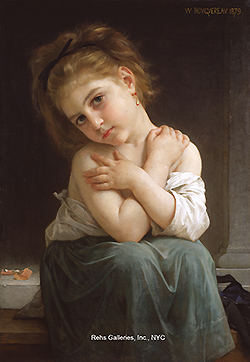 William A. Bouguereau (1825 - 1905) La Frileuse 28 1/4 x 19 3/4 inches Signed and dated 1879 SOLD Request More Info |

